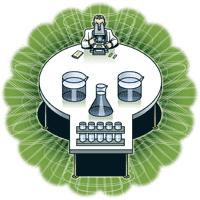
It has been called a modern-day Manhattan Project—a spending spree so vast and rapid that it might change the face of biological science. In the wake of 9/11, the U.S. government is funding a massive new biodefense research effort, redirecting up to $10 billion toward projects related to biological weapons such as anthrax. The Pentagon’s budget for chemical and biological defense has doubled; high-security nuclear-weapons labs have begun conducting genetic research on dangerous pathogens; universities are receiving government funding to build high-tech labs equipped to handle deadly infectious organisms; and Fort Detrick, Maryland, once the home of America’s secret bioweapons program, is about to break ground on two new high-tech biodefense centers.
Officials say the effort is designed to head off what a recent CIA report calls the “darker bioweapons future.” Intelligence briefings are awash with speculation about other nations or terrorists developing genetically engineered pathogens “worse than any disease known to man.” But a growing number of microbiologists, nonproliferation experts, and former government officials say there may be a dark side to the biodefense push: With poor oversight, government-funded scientists could actually be paving the way for the next generation of killer germs—and given the explosion of research, there is no way to keep track of what is being done. “We are playing games with fire,” says Ken Alibek, a top scientist in the Soviet Union’s bioweapons program until defecting to the United States. “It is kind of a Pandora’s box. As soon as you open it, there is no way of putting it back in.”
In a little-noticed report released in October, the National Academy of Sciences warned that the government has no mechanism to prevent the “misuse of the tools, technology, or knowledge base of this research enterprise for offensive military or terrorist purposes.” The report called for dramatically stepped-up monitoring of federally supported biodefense projects; so far, Congress and the administration have failed to act on those recommendations. Federal anti-terror legislation has focused on limiting access to stockpiles of known bioterrorism agents such as anthrax. But in a world where scientists can create deadly diseases in a test tube, says Dr. Ernie Takafuji, acting assistant director of biodefense at the National Institute of Allergies and Infectious Diseases, that is not enough. “When you come down to it, the threat is not just the organisms,” he explains. “The threat is the technologies.” The greatest danger, scientists and intelligence officials agree, stems from researchers’ increasing ability to alter the genetic codes of viruses and bacteria: The same information can be used either to treat disease or to make new germs— pathogens that could, for example, be designed to evade treatment or to genetically target specific populations.
Late last year, for example, Takafuji and other public-health officials were caught by surprise when an American virologist, Mark Buller, revealed that he was working on ways of creating a more deadly form of mousepox, a relative of smallpox, and was considering similar work on cowpox, which can infect humans. No one suggested that Buller, who has been working at St. Louis University to defeat known techniques for making pox viruses more lethal, sought to create a bioweapon. But the prospect of manufacturing a more deadly germ just to see how it could be killed worried many. “That is work that creates a new vulnerability for the United States and the world,” says Richard H. Ebright, lab director at the Waksman Institute of Microbiology at Rutgers University. “It’s like the National Institutes of Health was funding a research and development arm of Al Qaeda.” Buller himself, while defending the benefits of his own work, acknowledges the concerns over the new rush to biodefense research. “When you have thrown a lot of money at it,” he said, “people start to think very hard about what is possible, losing sight of what is practical.”
In another project that has raised eyebrows among bioweapons experts, a U.S. Army medical scientist in Maryland has been seeking to bring back to life key parts of the 1918 Spanish flu, a lethal influenza virus that killed 40 million people worldwide. While such research could be immensely valuable in fighting another deadly flu outbreak, it might also be used to create such an outbreak, notes Ed Hammond, director of the Sunshine Project, a group critical of American biodefense spending. “If [the researcher] worked in a Chinese, Russian, or Iranian laboratory,” he says, “his work might well be seen as the ‘smoking gun’ of a bio-warfare program.”
Even more worrisome to many experts is the apparent growth in secretive, or “black box,” biodefense research by the U.S. intelligence community. “There’s all kinds of secret research going on right now,” says Matthew Meselson, a Harvard biologist who has worked closely with the military. “The more you create secret research in biology,” he warns, “the more you create risk.” One program that has become public is Project Jefferson, a Pentagon effort to genetically engineer a vaccine-resistant version of anthrax. After the program’s existence was revealed by the New York Times in 2001, the Pentagon announced that it intended to complete the project and that the results would be classified. “[The military’s] natural instinct is to exploit the technology and keep everybody else away from it,” says John D. Steinbruner, director of the Center for International and Security Studies at the University of Maryland. “In their hands, this technology is potentially extremely dangerous.”
Programs like Project Jefferson have already raised concerns that U.S. scientists are treading dangerously close to the limits of the 1972 Biological Weapons Convention, which prohibits offensive research. Just months before September 11, the Bush administration walked away from negotiations to impose biological-weapons inspections, in part because American pharmaceutical companies did not want to open their labs to international inspectors. The abandonment of the talks left the world without any way to enforce the treaty’s restrictions. Now, experts fear that the explosion of American research—including programs such as Project Jefferson that are widely viewed as potential violations of the treaty—might encourage other countries to disregard the convention.
Despite these fears, the administration is pushing to expand research programs even further. In a rare unclassified report on the Pentagon’s biodefense plans, James B. Petro, a top official in the Defense Intelligence Agency, recently called for a new federal “threat assessment” facility for advanced bioweapons. Such a facility, he wrote, would investigate topics with “limited implications for the general bioscience community, but significant application for nefarious scientists.”
To many observers, the statement indicated that the United States is moving toward a pre-emptive approach, attempting to beat terrorists to the punch by being the first to produce novel pathogens. “What they seem to be saying to me is that we are actually in a defensive/offensive arms race,” says Malcolm Dando, a British bioweapons expert at Bradford University. “If the U.S. goes down these roads, it indicates routes that people can follow.”















